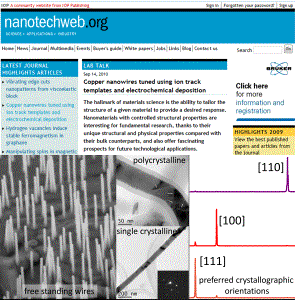
The scientists at Materials Research Group II, Institute of Modern Physics (IMP), CAS, have shown that the copper nanowires’ structures can be tailored using ion-track technique in combination with electrochemical deposition. The results recently were published in Nanotechnology 21(2010)365605. The community website nanotechweb.org, which is from IOP Publishing, reported this work simultaneously.
The hallmark of material science is the ability to tailor the structures of a given material to provide a desired response. Nanomaterials with controlled structural properties are not only interesting for fundamental research due to their unique structural and physical properties compared to their bulk counterparts, but also offer a fascinating potential for future technological applications. Though a large variety of strategies have been developed to fabricate metallic nanowires, the control over structural characteristics is still a challenge. Now, Prof. Jie LIU, Dr. Jinglai DUAN and group colleagues found that the crystallinities and crystallographic orientations of copper nanowires can be controlled using the techniques of electrochemical deposition in combination with ion tracks. The study reveals that low voltage and high temperature are favorable growth conditions for single crystalline wires, whereas, high voltage and low temperature are beneficial to the growth of polycrystalline wires. In polycrystalline wires, the anti-Hall-Petch effect is evident as predicted by theory. In addition, wires with preferred crystallographic orientations along [111], [100], or [110] directions can be modulated by changing the deposition conditions.
These findings imply that the techniques of electrochemical deposition in combination with ion-track membranes may provide a high degree of flexibility to grow metal nanowires with arbitrary structures and, as a result, offer a way to control the material’s functional performances. Although further studies are still needed involving different materials and sizes, these findings represent a step forward in understanding how to control the structural properties of metal nanowires. This challenge has captured the attention of a large part of the scientific community for the last two decades.
Due to similar growth mechanisms, the group's results may help in the structural tuning of other materials such as gold, silver, platinum, palladium, nickel, cobalt, bismuth, antimony, lead, tin, zinc, and so on.
The aforementioned work has been financially supported by West Light Talents Program of Chinese Academy of Sciences, National Natural Science Foundation of China, Natural Science Foundation of Gansu Province, and Foundation of President of Institute of Modern Physics, CAS.
Related Links
1. Controlled crystallinity and crystallographic orientation of Cu nanowires fabricated in ion-track templates, Nanotechnology 21(2010)365605
2. The report of nanotechweb.org
3. Surface Plasmon Resonances of Cu Nanowire Arrays, J. Phys. Chem C 113(2009)13583
4. Electrochemical fabrication of single-crystalline and polycrystalline Au nanowires: the influence of deposition parameters, Nanotechnology 17(2006)1922

